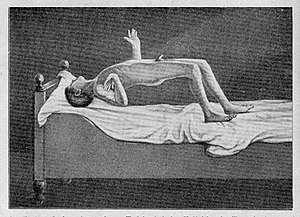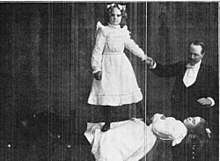Catalepsy
Catalepsy (from Greek κατάληψις "seizing, grasping") is a nervous condition characterized by muscular rigidity and fixity of posture regardless of external stimuli, as well as decreased sensitivity to pain.[1]
| Catalepsy | |
|---|---|
 | |
| Specialty | Psychiatry |
Signs and symptoms
.jpg)

Symptoms include a rigid body, rigid limbs, limbs staying in same position when moved (waxy flexibility), no response, loss of muscle control, and slowing down of bodily functions, such as breathing.[2]
Causes
Catalepsy is a symptom of certain nervous disorders or conditions such as Parkinson's disease and epilepsy. It is also a characteristic symptom of cocaine withdrawal, as well as one of the features of catatonia. It can be caused by schizophrenia treatment with anti-psychotics,[3] such as haloperidol,[4] and by the anesthetic ketamine.[5] Protein kinase A has been suggested as a mediator of cataleptic behavior.[6] Unsuggested waxy catalepsy, sometimes accompanied by spontaneous anesthesia, is seen as an indicator of hypnotic trance [7]. Suggested or induced rigid catalepsy, of extended limbs or even the entire body, sometimes tested with heavy weights, has been a staple of stage hypnosis shows and even academic demonstrations of hypnotism since the late 18th Century, as proof of extraordinary physical abilities possible in trance states. Such demonstrations have also been performed by Asian martial artists to prove the presence of "ki" or "chi" power, a kind of psychological or spiritual resource.
Historical cases
St. Teresa of Avila experienced a prolonged bout of catalepsy that began in 1539. This episode was precipitated by the stress she was suffering at the Carmelite Convent of the Incarnation. Her legs became rigid, leaving her an invalid for three years. Teresa endured intermittent attacks of catalepsy from then on.[8]
Artistic depictions
In the arts, catalepsy is often used for dramatic effect, sometimes as a plot device.
Literature
In Alexandre Dumas, père's novel The Count of Monte Cristo, the Abbé Faria has fits of catalepsy from time to time, before eventually dying from one.
In Eugène Sue's The Mysteries of Paris, the villain Jacques Ferrand experiences a fit described as cataleptic in his final confrontation with Rodolphe, blinded by lamplight and hallucinating with visions of his fantasized Cecily.
In George Eliot's Silas Marner, the main character Silas Marner frequently has cataleptic fits and seizures. It is not mentioned if they are caused by any of the aforementioned factors.
In Arthur Conan Doyle's "The Adventure of the Resident Patient", a man feigns catalepsy to gain access to a neurologist's rooms; the doctor attempts to treat him with amyl nitrite.
In Ford Madox Ford's The Good Soldier, the protagonist Dowell experiences catalepsy following the death of his wife.
In Robert A. Heinlein's Stranger in a Strange Land, the main character Valentine Michael Smith is believed to have catalepsy when he is returned to Earth.
In Edgar Allan Poe's "The Premature Burial", the narrator develops catalepsy. He fears being mistakenly declared dead and buried alive, and goes to great lengths to prevent this. In another of Poe's short stories, "The Fall of the House of Usher", Madeline Usher has catalepsy, and is buried alive by her unstable brother Roderick. Catalepsy is also depicted in "Berenice", thus becoming one of the recurrent themes in Poe's fiction.
In Poppy Z. Brite's Exquisite Corpse, the main character—Comptom, a serial killer (recreation of Jeffery Dahmer's life story) facing a lifetime sentence—uses shamanistic techniques to induce catalepsy, and, convincingly appearing deceased, is able to escape prison.
In Émile Zola's short story "La Mort d'Olivier Becaille" ("The Death of Olivier Becaille"), the title character is buried alive and notes that "I must have fallen into one of those cataleptic states that I had read of".
In Sax Rohmer's Fu Manchu novels, Dr. Fu-Manchu has a serum that induces a state of catalepsy so extreme as to be indistinguishable from death.
In Charles Dickens's novel Bleak House, Mrs. Snagsby has violent spasms before becoming cataleptic and being carried upstairs like a grand piano.
In Hegel's Lectures on the History of Philosophy: Greek Philosophy to Plato, Hegel describes Socrates as having catalepsy caused by magnetic somnambulism when in deep meditation.
In Charles Williams's novel Many Dimensions, Sir Giles Tumulty says to Lord Arglay, the Chief Justice of England: "You are a louse-brained catalept, Arglay."
In Philip K. Dick's novel Now Wait for Last Year, Kathy Sweetscent becomes immobilized by withdrawal from JJ-180, an alien (and highly addictive) drug. "My God, Kathy thought as she stood gazing down at the record by her feet. I can't free myself; I'm going to remain here, and they'll find me like this and know something's terribly wrong. This is catalepsy!"
In the second chapter of Álvares de Azevedo's Noite na Taverna, character Solfieri rescues a woman who has catalepsy from inside a coffin.
In the Ted Hughes poem titled "Conjuring in Heaven" from Crow (poetry), the eponymous character is left in a state of catalepsy.[9]
Other media
In the old time radio show Suspense theater, episode titled "Dead Ernest." Episodes number 205, 1946, and number 244, 1947. [10] In the movie Son of Dracula (1943,Universal Pictures), vampire hunter Professor Lazlo (J. Edward Bromberg) describes a vampire as being in a "cataleptic state" between sunrise and sunset, but practically "invincible" during the nighttime, to Dr. Harry Brewster( Frank Craven), as they look for answers to a number of strange situations involving Count Alucard (Lon Chaney Jr.).
References
- "Definition of Catalepsy".
- Sanberg PR, Bunsey MD, Giordano M, Norman AB (October 1988). "The catalepsy test: its ups and downs". Behav. Neurosci. 102 (5): 748–59. doi:10.1037/0735-7044.102.5.748. PMID 2904271.
- Rasmussen K, Hsu MA, Noone S, Johnson BG, Thompson LK, Hemrick-Luecke SK (November 2007). "The orexin-1 antagonist SB-334867 blocks antipsychotic treatment emergent catalepsy: implications for the treatment of extrapyramidal symptoms". Schizophr Bull. 33 (6): 1291–97. doi:10.1093/schbul/sbm087. PMC 2779883. PMID 17660489.
- Hattori K, Uchino S, Isosaka T, et al. (March 2006). "Fyn is required for haloperidol-induced catalepsy in mice". J. Biol. Chem. 281 (11): 7129–35. doi:10.1074/jbc.M511608200. PMID 16407246.
- Miller, Ronald (2005). Miller's Anesthesia. New York: Elsevier/Churchill Livingstone. ISBN 978-0-443-06656-6.
- Adams MR, Brandon EP, Chartoff EH, Idzerda RL, Dorsa DM, McKnight GS (October 1997). "Loss of haloperidol induced gene expression and catalepsy in protein kinase A-deficient mice". Proc. Natl. Acad. Sci. U.S.A. 94 (22): 12157–61. Bibcode:1997PNAS...9412157A. doi:10.1073/pnas.94.22.12157. PMC 23735. PMID 9342379.
- <Milton H. Erickson, edited by Ernest Rossi "Collected Papers of Milton H. Erickson, Irvington 1980>
- St. Teresa of Avila, The Life of St. Teresa de Avila, 1565, chapters V, VI, and VII.
- Hughes, T. (1972). Crow: From the Life and Songs of the Crow. London: Faber & Faber.
- Old Time Radio Researcher's Group https://otrr.org. Youtube: Old Time Radio, Suspense, Dead Earnest. https://www.youtube.com/watch?v=Ncb1N6InWLw or https://www.youtube.com/watch?v=YFUwDHzh2Fs